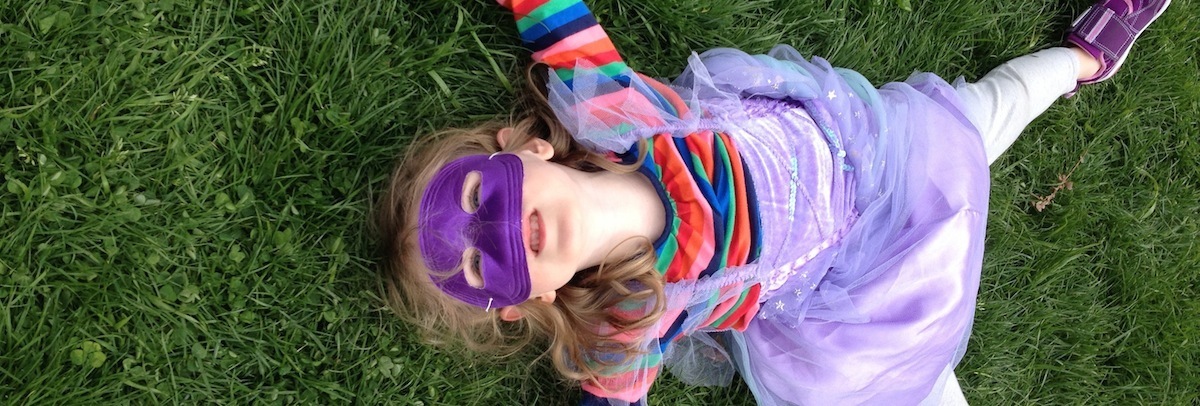A Twist on the Squiggle
-
Age: 3 to 8
-
Time: Under 1 hour
-
Materials: Ribbon, The Squiggle book
- Skills: Creativity, Imagination, Gross Motor, Self Esteem
Ribbon Squiggle Activity for Kids
Carole Lexa Schaefer’s beautiful book The Squiggle tells the story of a girl who finds a long, red ribbon lying on the sidewalk while she is walking to the park with her class. She uses her imagination to turn the squiggle of string into “slither slish...the dance of a big scaly dragon,” “crack crickle hiss—the sky trail of popping fireworks,” and more.
Read the book to your kids, then set out on a walk in the park, only to “stumble” on a scattering of pieces of red ribbon (that you have planted ahead of time, of course). Exclaim along with your kids, “Look! Squiggles!” Then, you and the kids grab them and start to twirl, run, dance, tie, twist, arrange, pull, and toss—joyfully imagining just like the young girl in Schaefer’s story. Can’t get your hands on a copy of the book? Just plant red ribbon (stands out anywhere), stumble, wonder and play. As your kids play, enjoy getting swept up in the fun.
The Guide
- Prep and plant the squiggles: Cut a 2-yard piece of ribbon for each person (child or adult) who’ll be out together. The squiggle is red in the book, but you can use any color that stands out. If you don't have ribbon, cut an old bed sheet into long strips. Find a spot alongside the woods, park, field or trail where you’ll be walking and toss the pieces of ribbon, aka the "squiggles," on the ground.
- Read The Squiggle by Carole Lexa Schaefer: If you can, get your hands on a copy and read it with your kids shortly before you go out to stumble upon the squiggles. Kids will make the connection more easily if you read just prior to your squiggle session. If you don’t have the book, that’s okay too. Plant the ribbons, act joyfully surprised when you find them, and proceed.
- Model the make believe: Even if your kid doesn’t need any encouragement to pick up the ribbon and start pretending, they will value and learn from the experience more if you are doing it too. How to model? Pick up a piece of ribbon and say something like, “What could this be? Hmm, I think mine is a snake slithering in the grass. Ssssss....” Maybe your ribbon is a rainbow leading to a leprechaun, an umbrella in a pretend rain storm or a the tail of your child’s favorite animal. Play out a few scenarios, moving your ribbon this way and that. Most kids will catch on and run with it.
- Let them play: Just enjoy watching them play and, as they wish, participate in their pretending. If they enjoy it, tuck the squiggles into your pack and keep them at the ready for another day of pretend play.
Why is this activity great for kids?
Whether you can get ahold of the book or not, you can easily create a magic moment for you and your kids. A simple object to manipulate, the element of surprise, and time and space for open-ended play—put these together, and you can orchestrate both bliss and wonder. When you join in the fun to play alongside them, you model that this behavior is valuable. In a world where even Legos come with kits that describe exactly how your creation is supposed to look, we need simple and undefined toys like the Squiggle to help foster creativity, inspire pretend play and to help kids see endless possibilities. In addition to these elegant thinking skills, kids develop gross motor skills as they race, hop, spin and jump to "activate" their squiggles.
As parents, one of the coolest parts of our job description is to be joy makers. Between drop offs, pick ups and meal making, however, it’s easy to forget this. My parents were full of little surprises like when they planted yummy treats in the backseat of the wagon before a long car ride. Brian vividly remembers the time his dad took him to the local pool to swim in the middle of a rainstorm. We can do that for our kids too. And, we don’t have to wait for Santa or the tooth fairy; we can do it on an ordinary Saturday in the yard or the park. A surprise is a powerful tool. It not only give kids a taste for joy, but it can teach them that the world is a delightful place—that they should keep their eyes open for the bits of joy waiting to be found. Happy surprises also create positive emotion in kids, which enhances their ability to learn from and remember the experience.
Finally, even though many kids this age are not yet reading independently, they are not too young to develop the habits of a good reader. Acting out a story or, better yet, taking a story and using it as a springboard for further imagining is a practice that helps readers learn to better comprehend a text—something that is hard to teach, but so valuable to learn.



